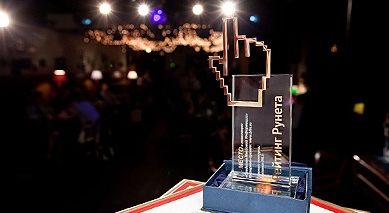Apocalypse has been cancelled!
Aliaksiej Kuĺbicki's exhibition opened in the Art Museum

Students of the Department of Humanities at Belarusian State University (BSU) had been gluing their installation for over four hours – the police officer let them out of the empty Art Museum after 11 p.m. The lecturer of the Department of Humanities at BSU Aliaksiej Kuĺbicki is satisfied – the first official exhibition of lomography in Belarus will take place! Gluing the photos, Aliaksiej told us a bit about the history of this art.
Aliaksiej Kuĺbicki:
“Lomography appeared in the 20th century in Prague. It was discovered by two Austrian students who came there for a weekend. They had old soviet cameras “Lomo” (manufactured by Leningrad Optics and Mechanical Organization). They took photos with these cameras and then they noticed that the images produced were a kind of blurry. However, they reflected the mood these people had during that weekend!”
The students immediately decided to create a new direction in photographic art on the basis of these “bad shots”, and the abbreviation “Lomo” was changed for a more fashionable one – “LoMo” (“love and motion”). Thus, Lomographic Society appeared in Vienna (because the students were from Vienna Academy of Fine Arts).

Aliaksiej Kuĺbicki:
“Now, there are about 70 branches of this society all over the world. Big exhibitions are held, even with participation of Ministers of Culture. Prizes and diplomas are awarded – to cut a long story short, there is lomographic “activity”. Unfortunately, so far nothing of the kind has been observed in our country. There were individual attempts; however, there were no big exhibitions, especially in an official establishment. Lomography is exhibited on lomowalls – a big area is covered with a big number of photos. It is great that the exhibition takes place in the Belarusian National Art Museum”.

A second-year student who studies “web-design”, Valeryja Lapickaja, says that the idea to arrange a lomographic exhibition during the Night of Museums came all of a sudden.
Valeryja Lapickaja:
“Once our group visited the Art Museum and we were suggested to take part in the Night of Museums. We decided to make a lomowall consisting of two parts. One part symbolizes the “Apocalypse”, the other one – “Apocalypse has been cancelled”. Our lomowall contains 555 photos. Each of them represents an individual story of each of us. All of them taken together make an interesting plot”.
Valeryja’s group mate Hanna Čyrykala admits that at first she understood nothing in all this.
Hanna Čyrykala:
“At first, I did photography but I did not know what lomography was. The lecturer told us about this concept. First, I did not understand anything because it looked like poor photos for me! I started searching for such photos in the Internet and I liked them. There are several photos with my stories here. On the other wall, I act as a model – there is half of my face which symbolizes the pressure the city exerts on a person as a result of which only half of the personality is left”.
The inspired lecturer compares his students, no less and no more, with Maksim Bahdanovič!

Aliaksiej Kuĺbicki:
“Sometimes I ask myself: why do we need this lomography if it is not understood by everyone? And I answer myself at once. 100 years ago, Maksim Bahdanovič wrote rondos, sonnets and triolets… What for? To have all these in Belarusian literature! The same is true about lomography. If it exists in the world, it should exist in the Belarusian photographic art! Belarus has to be involved in the international trend in photographic art”.
Hurry up! Lomographic walls “Apocalypse. Has been cancelled” will be exhibited in the National Art Museum at 7 p.m. on 18 May within the Night of Museums. The exhibition will last for three days.
Euroradio, 18 May 2012


